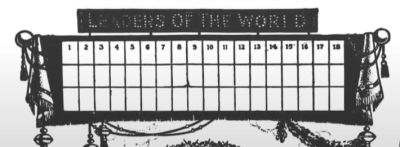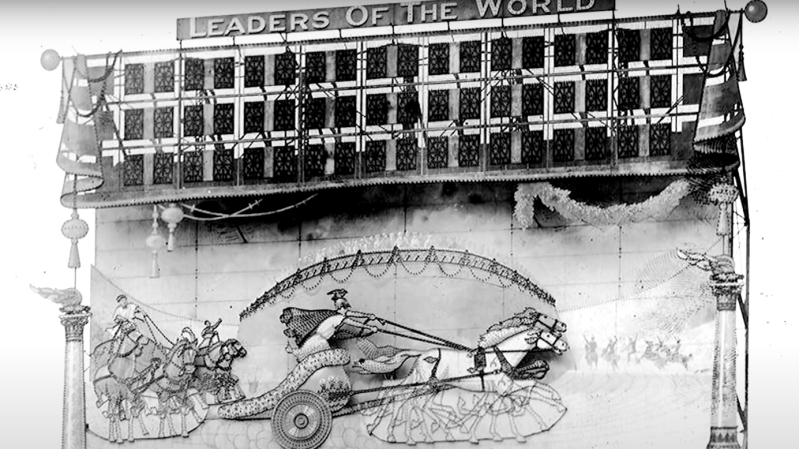Video blogger and display technology guru [Fran Blanche] has discovered a splendid retro-tech alphanumeric display from 1910. (Video, embedded below.)
We have always enjoyed her forays into old and unusual displays, including her project researching and reverse engineering an Apollo DSKY unit. This time [Fran] has dug up an amazing billboard from the early 20th century. It was built by the Rice Electric Display Company of Dayton Ohio, and operated in Herald Square for about two years. Requiring $400,000 in 1910-US-dollars to build, this was clearly an Herculean effort for its day and no doubt is the first example of selling advertising time on a computer-controller billboard. It boasts characters that are about 1.3 m tall and 1 m wide which can display letters, numbers, and various punctuation and symbols. These are arrayed into a 3-line 18-character matrix that is about 27 x 4 meters, and that’s up only a third of the total billboard, itself an illuminated and dynamic work of art.

There are quite a few tantalizing details in the video, but a few that jumped out at us are the 20,000 light bulbs, the 40 Hz display update rate, the 150 km of wire used and the three month long installation time. We would really like to learn more about these two 7.5 kW motorized switch controllers, how were they programmed, how were the character segments arranged, what were their shapes?
In the video, you can see triangles arranged in some pattern not unlike more modern sixteen segment displays, although as [Fran] points out, Mr Rice’s characters are more pleasing. We hope [Fran] can tease out more details for a future video. If you have any ideas or knowledge about this display, please put them in the comments section below. Spoiler alert after the video…
…this display is no longer standing.
















Fran… a class act, in a class by herself. Strange and wonderful, and the tech too!
Our lil world would be much the poorer without her.
There may be 20,000 bulbs but there aren’t 20,000 segments. Depending on whether characters were encoded with relay logic or just segment mapped there could be 400 to 1500 bits here. Could be tractable with Jacquard-style cards or something like a piano roll (maybe 15 pianos worth). Both those mechanisms had been around for 50 – 100 years by 1910.
Something similar to animate the horses below. Certainly a significant effort. Since ads would need to be added and removed often I’d guess Jacquard cards. Maybe with pneumatic actuators.
There are more bulbs than the ones in the segments. The chariots and other pieces of the picture below have bulbs to animate them.
20 segments for each of the 1080 characters, with maybe 1-6 bulbs per segment (there is a period which is a single dot), would only be 5000-6000 bulbs, so the rest of the 20000 would either be for the chariot, or maybe some of the segment bulbs are clustered like on LED road signs. But when I looked closely the other day, it seemed like there were only 5 or 6 “bumps” per segment.
In any case, this is a tremendously amazing display. And all the scaffolding behind it makes it look like a Minecraft computer. It probably used piano rolls for the messages, but it cycled through messages every thirty seconds or so, which puts some restrictions on how it might have worked.
Is it a stretch to say this is absolutely the world’s first search display? Just as there is now controversy regarding who first invented the incandescent lightbulb, perhaps such discoveries exist elsewhere pre-dating this find.
Nonetheless, good presentation by Fran… As always.
I was surprised how long the seven-segment display has been around. Knuth managed to dig up a patent (US 974943) dating back to 1910: https://patents.google.com/patent/US974943A/en
How is good ol’ Donald?
That is a remarkable smooth font for a segment display.
600HP for 20K bulbs seemed high until Edison was mentioned having part . Tesla must have been out of town. Snicker. 40hz update and heavy power usage suggests a DC system to me. That and would be easier to get timing right.
Cascade of neon bulbs likely. Not tubes. Possibly mercury vapor. Too many guesses. Doubt will find a complete schematic. Damnit.
Programming would be cool to have a definitive answer to as well.
That is absolutely a cool project for its time. To bad there isn’t any drawing surviving of the project, so that If one had the time, to duplicate it in miniature with led technology of today what they did then. Looks like there ‘might’ be enough detail to duplicate the segments from the pictures. What a time period to be part of technology wise… Electrical, auto, airplane, etc… innovations just starting to get going. Anyway, enjoyed the article and the video.
Seems like Fran is on a mission to find, document and (where possible) acquire examples of every obscure numeric/alphanumeric display technology on the planet. Nimo tubes. Binaview. Projection displays. The EL display from the Apollo dsky.
Ben Hur the novel was still big then and the Ben Hur Tavern 1903 is only 6 years older. This is almost one of those alternate universe things. The ball and tassel art along side this kinda display is very steampunk. I am thinking that since an electrical company built it that player piano tech wouldn’t be used. Instead the 40 Hz thing makes me think big rotating drum full of tacks or pins. This is for the horse diorama not the letters. Think marble machine. Oh, and there’s a player roll of the Ben Hur Chariot Race right around 1910, it must have been a hit. I have seen a few copies in my life. I will have to check the copyright date. That would make for a good segment of period music in Fran’s video.
Someone here needs to breakdown how many segments and their geometry for a printable display with LED’s. It is very readable, far more than some I’ve seen here. With photoshop and animation it should be possible to reanimate the diorama.
If only they had left off the Ben Hur ripoff, the text display could have lasted the storm and maybe a world war or two. The scrolling display on Times Square wasn’t too far off in the future. Another for Fran, I’d hope there is a little more info on it.
The flashing tubes might be Geissler tubes. This patent (US452514A) from 1891 for a ‘Luminous Sign’ refers to them:
https://patentimages.storage.googleapis.com/4f/0f/75/3b8d43e4b5ac97/US452514.pdf
Still at it. Check out his web site https://www-cs-faculty.stanford.edu/~knuth/
A web site like websites should be, btw.
Disappointed…
The title said Fran “finds 4 foot alphanumeric displays”
So, where are they?
They’re lumped in with the quadruped displays.
For the six foot displays, they’re of course categorised under the insectoid section.
Is there a closer picture of the segments? I assume in the pictures, the dark lines are the segments and the light triangualar sections are spaces between them.
It would be quite cool to recreate these segments displays.
This cool video shows how you would have programmed a sign like this in 1935 https://archive.org/details/0140_Behind_the_Bright_Lights_M00204_07_40_34_08
The characters were not “about 1.3 meters tall and one meter wide,” they were 4 feet tall and 3 feet wide.
Glad to see she is on here.
I’m a fan of Fran!